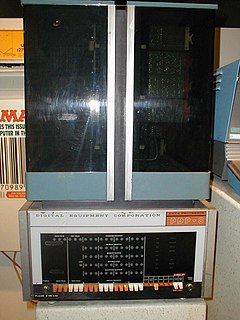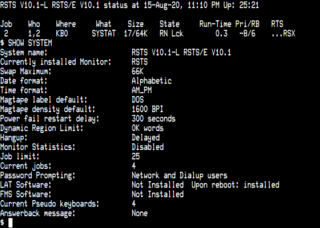
Digital Equipment Corporation, using the trademark Digital, was a major American company in the computer industry from the 1960s to the 1990s. The company was co-founded by Ken Olsen and Harlan Anderson in 1957. Olsen was president until forced to resign in 1992, after the company had gone into precipitous decline.

A minicomputer, or colloquially mini, is a class of smaller general purpose computers that developed in the mid-1960s and sold at a much lower price than mainframe and mid-size computers from IBM and its direct competitors. In a 1970 survey, The New York Times suggested a consensus definition of a minicomputer as a machine costing less than US$25,000, with an input-output device such as a teleprinter and at least four thousand words of memory, that is capable of running programs in a higher level language, such as Fortran or BASIC.

Digital Equipment Corporation (DEC)'s PDP-10, later marketed as the DECsystem-10, is a mainframe computer family manufactured beginning in 1966 and discontinued in 1983. 1970s models and beyond were marketed under the DECsystem-10 name, especially as the TOPS-10 operating system became widely used.

The PDP-11 is a series of 16-bit minicomputers sold by Digital Equipment Corporation (DEC) from 1970 into the 1990s, one of a set of products in the Programmed Data Processor (PDP) series. In total, around 600,000 PDP-11s of all models were sold, making it one of DEC's most successful product lines. The PDP-11 is considered by some experts to be the most popular minicomputer.

VAX is a series of computers featuring a 32-bit instruction set architecture (ISA) and virtual memory that was developed and sold by Digital Equipment Corporation (DEC) in the late 20th century. The VAX-11/780, introduced October 25, 1977, was the first of a range of popular and influential computers implementing the VAX ISA. The VAX family was a huge success for DEC – over 100 models were introduced over the lifetime of the design, with the last members arriving in the early 1990s. The VAX was succeeded by the DEC Alpha, which included several features from VAX machines to make porting from the VAX easier.

RSX-11 is a discontinued family of multi-user real-time operating systems for PDP-11 computers created by Digital Equipment Corporation. In widespread use through the late 1970s and early 1980s, RSX-11 was influential in the development of later operating systems such as VMS and Windows NT.
RT-11 is a discontinued small, low-end, single-user real-time operating system for the full line of Digital Equipment Corporation PDP-11 16-bit computers. RT-11 was first implemented in 1970. It was widely used for real-time computing systems, process control, and data acquisition across all PDP-11s. It was also used for low-cost general-use computing.

The Electronika BK is a series of 16-bit PDP-11-compatible fanless home computers developed under the Electronika brand by NPO Scientific Center, then the leading microcomputer design team in the Soviet Union. It is also the predecessor of the more powerful UKNC and DVK micros.

The PDP-6, short for Programmed Data Processor model 6, is a computer developed by Digital Equipment Corporation (DEC) during 1963 and first delivered in the summer of 1964. It was an expansion of DEC's existing 18-bit systems to use a 36-bit data word, which was at that time a common word size for large machines like IBM mainframes. The system was constructed using the same germanium transistor-based System Module layout as DEC's earlier machines, like the PDP-1 and PDP-4.

The history of computing hardware starting at 1960 is marked by the conversion from vacuum tube to solid-state devices such as transistors and then integrated circuit (IC) chips. Around 1953 to 1959, discrete transistors started being considered sufficiently reliable and economical that they made further vacuum tube computers uncompetitive. Metal-oxide-semiconductor (MOS) large-scale integration (LSI) technology subsequently led to the development of semiconductor memory in the mid-to-late 1960s and then the microprocessor in the early 1970s. This led to primary computer memory moving away from magnetic-core memory devices to solid-state static and dynamic semiconductor memory, which greatly reduced the cost, size, and power consumption of computers. These advances led to the miniaturized personal computer (PC) in the 1970s, starting with home computers and desktop computers, followed by laptops and then mobile computers over the next several decades.

RSTS is a multi-user time-sharing operating system developed by Digital Equipment Corporation for the PDP-11 series of 16-bit minicomputers. The first version of RSTS was implemented in 1970 by DEC software engineers that developed the TSS-8 time-sharing operating system for the PDP-8. The last version of RSTS was released in September 1992. RSTS-11 and RSTS/E are usually referred to just as "RSTS" and this article will generally use the shorter form. RSTS-11 supports the BASIC programming language, an extended version called BASIC-PLUS, developed under contract by Evans Griffiths & Hart of Boston,. Starting with RSTS/E version 5B, DEC added support for additional programming languages by emulating the execution environment of the RT-11 and RSX-11 operating systems.
DIBOL or Digital's Business Oriented Language is a general-purpose, procedural, imperative programming language, designed for use in Management Information Systems (MIS) software development.

DECtape, originally called Microtape, is a magnetic tape data storage medium used with many Digital Equipment Corporation computers, including the PDP-6, PDP-8, LINC-8, PDP-9, PDP-10, PDP-11, PDP-12, and the PDP-15. On DEC's 32-bit systems, VAX/VMS support for it was implemented but did not become an official part of the product lineup.

The Professional 325 (PRO-325), Professional 350 (PRO-350), and Professional 380 (PRO-380) are PDP-11 compatible microcomputers introduced in 1982 by Digital Equipment Corporation (DEC) as high-end competitors to the IBM PC.
On-line Debugging Tool (ODT) is a family of several debugger programs developed for Digital Equipment Corporation (DEC) hardware. Various operating systems including OS/8, RT-11, RSX-11, and RSTS/E implement ODT, as did the firmware console of all of the LSI-11-family processors including the 11/03, 11/23/24, 11/53, 11/73, and 11/83/84.
BASIC-11 was a dialect of the basic language for PDP-11 operating systems such as RSX-11, RT-11, TSX and TSX-Plus. It was a classic BASIC in that it used line numbers, supported line number editing, and classic function syntax. It provided extended support for user-defined functions, external sequential disk files, and linking with assembler language modules for device support and operating system interfaces.
TSX-32 has been a general purpose 32-bit multi-user multitasking operating system for x86 architecture platform, with a command line user interface. It is compatible with some 16-bit DOS applications and supports file systems FAT16 and FAT32. It was developed by S&H Computer Systems, and has been available since 1989.
MONECS was a computer operating system with BASIC, COBOL, FORTRAN, Pascal interpreters, plus machine language facility. Specifically designed for computer science education in Australian secondary schools and at the university undergraduate level. Alternative designations were DEAMON or SCUBA systems.
Synergy DBL is a compiled, imperative programming language designed for business use. The language was originally called DBL; later it was referred to as Synergy Language; as of 2012 the official name is Synergy DBL. It is based on Digital Equipment Corporation’s DIBOL programming language.
Commercial Operating System (COS) is a discontinued family of operating systems from Digital Equipment Corporation.











